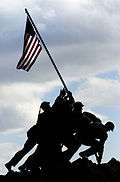G.I. Generation
| Part of a series on |
| Generations |
|---|
| Lost Generation |
| G.I. Generation |
| Silent Generation |
| Baby boomers |
| Generation X |
| Millennials |
| Generation Z |
G.I. Generation (also known as the Greatest Generation and the WWII Generation) is the demographic cohort following the Lost Generation. There are no precise dates for when this cohort starts or ends; demographers and researchers typically use starting birth years ranging from the early 1900s to early 1910s and ending birth years ranging from the mid-to-late 1920s.
Definition
Demographers William Stauss and Neil Howe coined the term "G.I. Generation" in their 1991 book Generations: The History of America's Future[1] and use 1901–1924 as birth years.[2] The initials "G.I." of "G.I. Generation" is military terminology referring to "Government Issue" or "General Issue". This cohort is also referred to as the "WWII Generation".[3]
Pew Research Center defines this cohort as being born from 1910–1927.[4]
The term The Greatest Generation comes from the title of 1998 book by American journalist Tom Brokaw, which profiled Americans members of this generation who came of age during the Great Depression and went on to fight in World War II, as well as those who contributed to the war effort on the home front. In the book, Brokaw argued that these men and women fought not for fame or recognition, but because it was the "right thing to do."[5]
See also
References
- ↑ Strauss, William; Howe, Neil (1991). Generations: The History of America's Future, 1584 to 2069. Harper Perennial. p. 335
- ↑ Howe, Neil (30 July 2014). "The G.I. Generation and the "Triumph of the Squares"". Forbes. Retrieved 26 November 2016.
- ↑ "The Greatest Generation". Investopia. Retrieved 26 November 2016.
- ↑ http://www.pewresearch.org/files/old-assets/pdf/1497.pdf
- ↑ The greatest generation - Tom Brokaw - Google Boeken. Books.google.com. Retrieved 2013-12-16.
